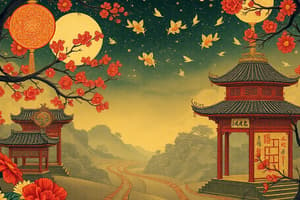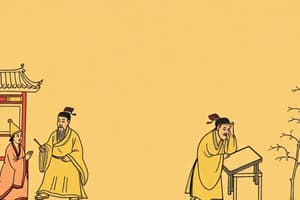Podcast
Questions and Answers
What was the primary reason for the constraint of foot binding in China?
What was the primary reason for the constraint of foot binding in China?
- To symbolize social status
- To restrict women's physical mobility
- To signify deference to men (correct)
- To show religious devotion
What was the characteristic of Neo-Confucianism that emerged in China between 770 and 840?
What was the characteristic of Neo-Confucianism that emerged in China between 770 and 840?
- It combined rational thought with abstract ideas of Daoism and Buddhism (correct)
- It was strictly based on Buddhist principles
- It emphasized only rational thought
- It rejected all abstract ideas
What was the major difference between the aristocracy in Korea and China?
What was the major difference between the aristocracy in Korea and China?
- Korean aristocracy maintained more power and allowed less social mobility (correct)
- Korean aristocracy was weaker than the Chinese
- Korean aristocracy was strictly based on Buddhist principles
- Korean aristocracy was more centralized than the Chinese
What was a characteristic of Vietnamese social structure?
What was a characteristic of Vietnamese social structure?
What was the contribution of Nasir al-Din al-Tusi in mathematics?
What was the contribution of Nasir al-Din al-Tusi in mathematics?
What was the characteristic of the bureaucracy in Vietnam?
What was the characteristic of the bureaucracy in Vietnam?
Which of the following best describes the impact of the Song Dynasty on China's economy?
Which of the following best describes the impact of the Song Dynasty on China's economy?
What was the primary purpose of the tributes in China during this period?
What was the primary purpose of the tributes in China during this period?
What was the significance of the Grand Canal in China during this period?
What was the significance of the Grand Canal in China during this period?
What was a result of the development of agriculture in China during this period?
What was a result of the development of agriculture in China during this period?
What was a characteristic of the Song government's approach to social welfare?
What was a characteristic of the Song government's approach to social welfare?
What was a result of the spread of gunpowder technology from China?
What was a result of the spread of gunpowder technology from China?
Flashcards are hidden until you start studying
Study Notes
Religious Diversity in China
- Buddhism arrived in China from India via the Silk Roads, with three forms: Theravada, Mahayana, and Tibetan Buddhism.
- Buddhism emphasized the Four Noble Truths and the Eightfold Path.
Neo-Confucianism in China
- Evolved between 770 and 840, combining rational thought with Daoist and Buddhist ideas.
Feudalism in Japan
- Japan was a feudal society without a centralized government for hundreds of years.
- Landowning aristocrats (daimyo) battled for control, while most people worked as rice farmers.
- In 1192, the Minamoto installed a shogun (military ruler) to reign, but regional rivalries among aristocrats persisted for four centuries.
- Not until the 17th century did shoguns create a strong central government that unified the country.
Korea's Connection to China
- Korea had a direct relationship with China and a tributary relationship.
- Korea centralized its government in the Chinese style.
- Koreans adopted Confucian and Buddhist beliefs.
- The aristocracy maintained power, limiting social mobility.
Social Structures in Vietnam
- Vietnamese women enjoyed greater independence in their married lives compared to Chinese women in the Confucian tradition.
- Vietnamese preferred nuclear families, with father, mother, and children living together.
- Villages operated independently of a national government, with no political centralization.
- A merit-based bureaucracy of educated men emerged, with officials owing allegiance to village peasants rather than the emperor.
Developments in Dar al-Islam
- Nasir al-Din al-Tusi advanced mathematics, making trigonometry a separate subject.
- ‘A’ishah al-Ba’uniyyah was a prolific female Muslim writer, describing her journey toward mystical illumination.
- Medical advances and hospital care improved in cities.
Developments in East Asia
China: The Song Dynasty
- The Song Dynasty (960-1279) brought great wealth, political stability, and artistic and intellectual innovations to China.
- China developed the greatest manufacturing capability in the world.
- China became the most commercialized society, shifting from local production to market production.
- Buddhism and Confucianism spread, and China's bureaucracy expanded through meritocracy, allowing for greater social mobility.
Economic Developments in Postclassical China
- The Grand Canal: an efficient waterway transportation system that enabled China to become the most populous trading area in the world.
- Gunpowder: technology spread from China to Eurasia via traders on the Silk Roads.
- Agriculture: elaborate irrigation systems and heavy plows increased productivity, leading to population growth.
- Tributes: an arrangement in which other states paid money or provided goods to honor the Chinese emperor.
Social Structures in China
- The Song government provided aid to the poor and established public hospitals for healthcare.
Studying That Suits You
Use AI to generate personalized quizzes and flashcards to suit your learning preferences.




